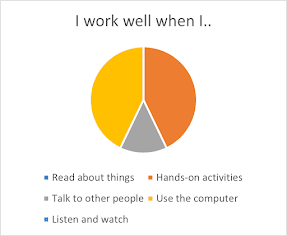Gathering and Interpreting Student Data
Data... get it... look at... use it.
In education, data is at the center of everything. Data guides and directs our choices as teachers on what, when, and how to teach our students. Keep reading to see how I use data on student learning styles to inform my teaching choices!
Here are some sample graphs of data collected from learning inventories:
Learning styles is a term used by educators that is often a combination of instructional preferences and and cognitive style (Sadler-Smith, 2001). With this information, it makes sense that learning preferences/styles would have a connection with student development in not only academics, but social, communication, and more.
All students in the group observed have an IEP and receive special education services in a combination of academics, gross and fine motor, speech and communication, and daily living skills. All of these students chose hands-on activities for how they learn best. Due to their disabilities, hands-on activities provide support for assisting students with understanding concreate and abstract concepts in visual, concreate ways. Hands-on activities also help students express their knowledge and understanding without having to have high verbal communication skills. This assists us with getting a better understanding of what they know and where they are stuck.
How learning styles affect planning
Research shows that most people have more than one learning style and it is important to try and incorporate multiple learning styles into your teaching in order to give students the best support and resources possible to be successful (Staake, 2023). Knowing how your students learn best helps you to plan your lessons and activities. Now that I know that the students in this group benefit from hands-on learning in small group settings, I can use that information when planning future lessons and activities. For example, instead of just reading a passage to the students about a topic, I could get the students involved by having hands on activities that go along with the passage I am reading aloud, make sure the passage has visual supports and pictures to go along with the text for my visual learners, and provide opportunities for movement as many of the students mentioned that they enjoyed having time to move during lessons.
When planning instruction, it is important to take into consideration student strengths, interests, and needs. The consideration of all three aspects builds a foundation for a lesson that can lead to student success. Use student strengths to help build confidence and allow them to encourage and help other classmates whose strengths differ from their own. These strengths can be determined by evaluating previous student work samples, classroom data, discussion with the child, and observations. Integrating student interests into lessons and activities help students to become and remain engaged and make connections to previous learning in their brain which helps with storing information to memory. Interests can be determined through formal or informal student questionnaires, observing the student during free time, having conversations with students about what they enjoy doing, and observing conversations they have with friends and peers. Lastly, student needs need to be determined in order to make sure you are teaching the material/skill that the student needs assistance with. There is no need to teach a lesson on a skill or topic that the entire class has mastered. By collecting data through formal and informal assessments and observations, you can get information on where students are and what they need help with.
Assessments
Not only is it important to take into consideration learning styles when planning instruction, but you also need to provide assessments that support a variety of learning styles (Edwards, 2021). How many of us know someone, or even ourselves, who can demonstrate mastery during practice or activities, but once a test is put in front of us, we fail to show what we know and what we can do. There are many ways to help students with this. One way is to provide a variety of options for students to choose from to show mastery of the topic. For example, for older students, you could have students choose between writing an essay, creating a presentation (PowerPoint, poster, 3D model, etc.), or taking a standard questionnaire assessment.
Resources
Edwards, S. (2021). Designing assessments according to learning styles. Progressive Mastery Learning. https://teachbetter.com/blog/designing-assessments-according-to-learning-styles/
Sadler-Smith, E. (2001). The relationship between learning style and cognitive style, Personality and Individual Differences. https://www.sciencedirect.com/science/article/pii/S0191886900000593
Staake, J. (2023). What are learning styles and how should teachers use them. We Are Teachers. https://www.weareteachers.com/learning-styles/




Comments
Post a Comment